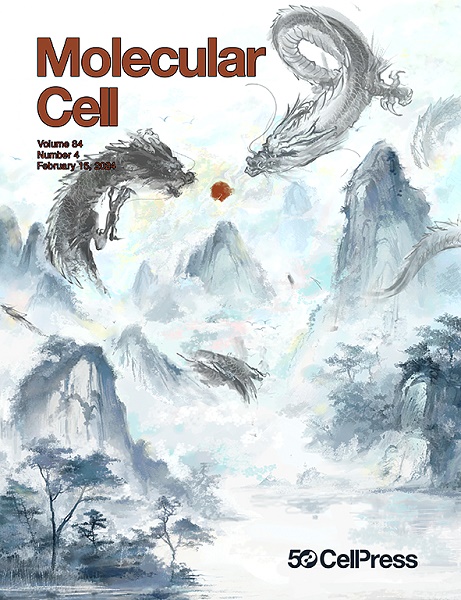FMRP drives mRNP targets into translationally silenced complexes
IF 14.5
1区 生物学
Q1 BIOCHEMISTRY & MOLECULAR BIOLOGY
引用次数: 0
Abstract
Fragile X syndrome (FXS) results from a deficiency of the ubiquitously expressed RNA-binding protein fragile X protein (FMRP). While FMRP-mediated translational repression has been attributed primarily to ribosome stalling, using immunoprecipitations and polysome profiling of non-polar- and polar-cell lysates and liquid chromatography-tandem mass spectrometry (LC-MS/MS) analyses, we show that mammalian FMRP largely represses translation initiation by associating with granule constituents to preclude 40S ribosomal subunit binding. We demonstrate that FMRP associates with its target mRNAs by binding directly to eukaryotic translation initiation factor 4E (eIF4E) at the 5′ cap in competition with eIF4G1 and that ataxin-2-like promotes FMRP binding to the transcribed body. The KH1 + KH2 domains of FMRP are critical for the co-immunoprecipitation of eIF4E, mRNA targets, ataxin-2-like, and PABPC1. Our findings supplement FMRP-mediated ribosome-stalling data, suggesting that FMRP largely mediates the sequestration of its mRNA targets from translation initiation and degradation in a network of FMRP molecules that simultaneously associate with cap-bound eIF4E, GC-rich mRNA regions, and poly(A)-bound PABPC1.

FMRP驱动mRNP靶点进入翻译沉默复合物
脆性X综合征(FXS)是由普遍表达的rna结合蛋白脆性X蛋白(FMRP)缺乏引起的。虽然FMRP介导的翻译抑制主要归因于核糖体延迟,但通过免疫沉淀和非极性和极性细胞裂解物的多体分析以及液相色谱-串联质谱(LC-MS/MS)分析,我们发现哺乳动物FMRP通过与颗粒成分结合来阻止40S核糖体亚基结合,在很大程度上抑制了翻译起始。我们证明FMRP通过直接结合真核翻译起始因子4E (eIF4E)在5 '帽与eIF4G1竞争而与目标mrna结合,并且ataxin-2-like促进FMRP与转录体结合。FMRP的KH1 + KH2结构域对于eIF4E、mRNA靶点、ataxin-2-like和PABPC1的共免疫沉淀至关重要。我们的研究结果补充了FMRP介导的核糖体停滞数据,表明FMRP在很大程度上介导了FMRP分子网络中mRNA靶标的翻译起始和降解,这些分子同时与帽结合的eIF4E、富含gc的mRNA区域和poly(a)结合的PABPC1相关。
本文章由计算机程序翻译,如有差异,请以英文原文为准。
求助全文
约1分钟内获得全文
求助全文
来源期刊

Molecular Cell
生物-生化与分子生物学
CiteScore
26.00
自引率
3.80%
发文量
389
审稿时长
1 months
期刊介绍:
Molecular Cell is a companion to Cell, the leading journal of biology and the highest-impact journal in the world. Launched in December 1997 and published monthly. Molecular Cell is dedicated to publishing cutting-edge research in molecular biology, focusing on fundamental cellular processes. The journal encompasses a wide range of topics, including DNA replication, recombination, and repair; Chromatin biology and genome organization; Transcription; RNA processing and decay; Non-coding RNA function; Translation; Protein folding, modification, and quality control; Signal transduction pathways; Cell cycle and checkpoints; Cell death; Autophagy; Metabolism.
 求助内容:
求助内容: 应助结果提醒方式:
应助结果提醒方式:


